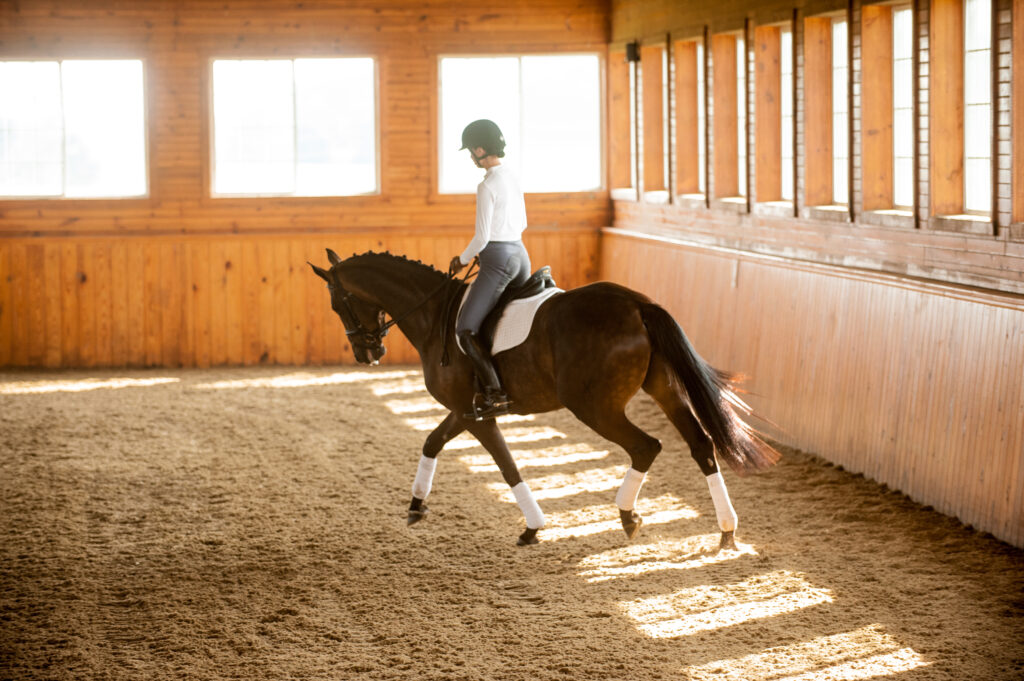Q: My new horse has a lot of potential, but I’m having trouble teaching him to bend around corners and be more flexible. Any hints?

JORDAN LINSTEDT
A: To bend well and be flexible, your horse must develop a great deal of strength in his back and hindquarters— in fact, in his entire body. To travel correctly around a turn or circle, your horse must bend his body through his rib cage, rather than simply turn his nose to the inside. It takes time to develop the balance and strength necessary to do this well, so be patient with your horse. Here are some tips to get you headed in the right direction:
Start by evaluating your rein contact. A good bend comes from your legs, not the reins. Ideally, you should use twice as much leg aid as you do hand. From the very beginning, you want to have a light, elastic connection to your horse’s mouth. As he grows stronger and uses his back and body more, he should trust your hands enough to move forward into a more solid contact, but it should never become heavy. I aim to feel no more than 1 to 2 pounds of pressure in each hand.
Your contact with a young and/ or learning horse also needs to be equal on both reins. Before you can ask him to bend properly, he must travel straight. And he can’t be straight if your contact is uneven. So concentrate on riding him forward into an even connection in both reins.
Also check that your position is centered and balanced, with your weight distributed evenly down through both legs. The better balanced you are, the better balanced and straight your horse will be. If your position tips too much to one side or the other, you’ll feel the opposite foot get lighter in the stirrup. To correct this, step down firmly into that stirrup iron.
When your balance and contact feel reliably consistent, try this spiral exercise:
Begin at the trot on a 20-meter circle. Shift your weight slightly onto your inside seat bone, still keeping the rest of your weight equally distributed through both legs and maintaining your even contact in both reins. With your inside leg at the girth and your outside leg just behind the girth, think of using your legs—more than your reins—to ride your horse’s rib cage to the outside of the circle.
Now gradually spiral in, taking several rotations to shrink the circle to a diameter of 10 to 15 meters, depending on what your horse can do comfortably. (Don’t reduce the size of the circle to a point where he loses momentum or seems to be struggling in any way.) As the circle gets smaller, your horse naturally will have to bend more. Be careful not to over-flex his nose to the inside—remember, the bend should be as much in his rib cage as in his neck. Also be sure to stay connected to him with your outside rein and outside leg.
When you reach the smaller circle, slowly spiral out again. Repeat this once or twice and then do the same thing in the other direction. If you continue to practice this exercise over time, you’ll begin to feel his body bend around your inside leg, with your outside rein and leg controlling the shape and size of the circle.
As your horse’s strength develops, use your diagonal aids to introduce a slight counter bend. Trotting again on a 20-meter circle, reverse your leg positions, moving your inside leg just behind the girth and your outside leg on the girth, and ask your horse to bend his body slightly to the outside for a few strides while staying on track on the circle. You can play with changing back and forth between the true bend and counter bend on diagonals, serpentines and along the rail. This will gradually improve his suppleness.
When your horse begins to produce a good bend and counter bend, if you know the aids for performing a leg-yield, use that as another suppling tool. As you trot across a diagonal, several strides before you reach the far corner turn slightly toward the new direction (for example, if you’re about to turn to the right, apply your right-bending aids) and ask for a few steps of leg-yield into the corner (in this example, moving away from your right leg). This will help to get your horse deeper into the corners while improving his balance and bend.
Throughout this training process, whether you’re a beginner or advanced- level rider, you’ll progress most quickly if you have an eye on the ground—a trainer or other experienced horse-person watching your work to confirm that you’re doing it correctly. With this support—and a great deal of patience—you can teach any horse to bend.
Rising eventing star Jordan Linstedt, 24, began riding at age 2, when her mother ponied her on trails. As a teenager, with guidance from Olympic eventer Todd Trewin, she brought several off-the-track racehorses up through the levels.
When she was a senior in college, Jordan’s parents purchased a 17.3-hand imported Irish sport horse gelding, Tullibards Hawkwind, or Jack. Six years later, after working with several top trainers, including British Olympic gold medalist Leslie Law, Jordan and Jack completed their first four-star event at the 2012 Rolex Kentucky Three-Day Event with a steady, clear cross-country round.
Jordan currently trains and teaches at her mother’s Saddle Rock Stables in Redmond, Washington. She also takes online classes at the University of Washington, where she is studying society, ethics and human behavior.
This article originally appeared in the June 2013 issue of Practical Horseman.










